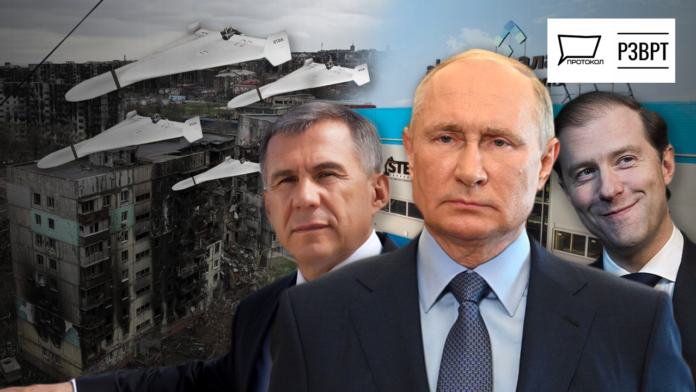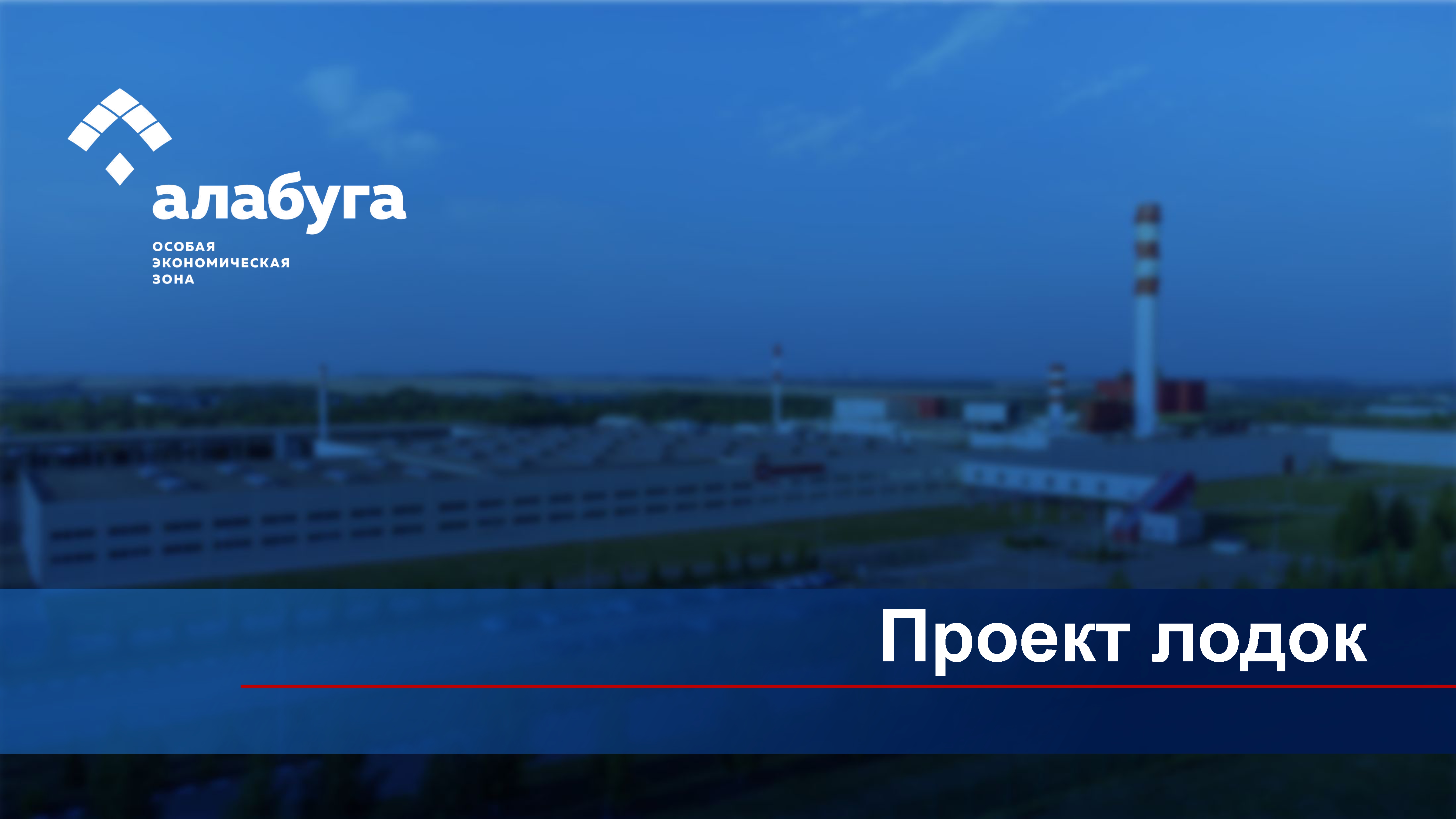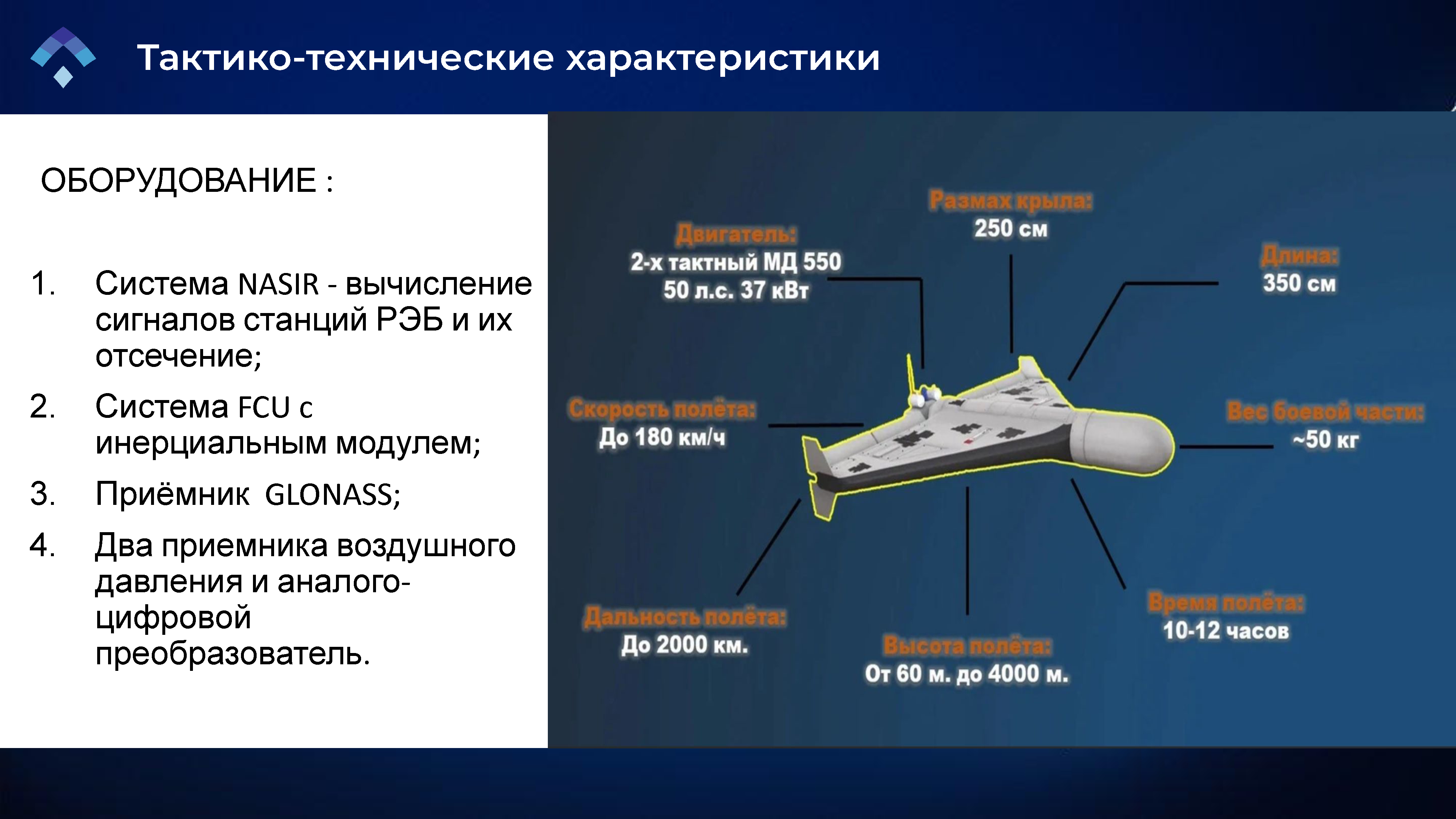In this article, we tell the story of how Iranian drones are being produced in Tatarstan, who is responsible for it, and why the peaceful project «Alabuga Special Economic Zone» has become a new launching pad for the Russian military-industrial complex. This is a joint investigation by the «Protokol» publication and the YouTube-channel «RZVRT». You are reading the first part of our investigative series on «Alabuga».
In recent months, Russia has increasingly been using not only missiles but also combat drones of Iranian origin for attacks on Ukraine. On the night of May 28, a record number of drones, 54 “Shahed” drones, struck Kiev. Out of those, 52 were shot down by air defense systems. At least one person died.
And then, on the night of May 30, another 31 “Shahed” drones, according to the Ukrainian side, were shot down, with 29 of them confirmed. Look at this footage. Here is an injured man standing next to a residential building hit by a “Russian” drone, and here is a woman holding a dog, looking at her house that was also hit by a “Shahed” drone. Or this woman in an ambulance — the strike was carried out at 4:30 a.m. with the aim of terrorizing innocent people in Kiev. Today, we will explain what made this terror possible.
Chapter I. We Started Off Strong
The Russian name for this place is Yelabuga. Yelabuga District is a district in the Republic of Tatarstan, not far from Naberezhnye Chelny. The Tatar name differs by only one letter, Alabuga. In the 1980s, there were plans to develop industry here: a hydroelectric power station was launched, new factories were opened, and the production of tractors, engines, and machinery was planned. By the end of the 1980s, it was decided to produce small cars instead of tractors, but soon the Soviet Union ceased to exist.
In the 1990s, there was still some production here, but the most interesting developments started closer to the early 2000s. 25 years ago, on April 22, 1998, the law «On the Alabuga Free Economic Zone» was adopted at the republic level. It would be repealed later. A full-fledged special economic zone (SEZ) was established here only in 2006. The official opening ceremony was attended by the Minister Elvira Nabiullina, Head of the Federal Agency for the Management of Special Economic Zones Mikhail Mishustin, and Deputy Minister of Industry Denis Manturov.
Against the backdrop of crises faced by other special economic zones, some of which were even closed in the 2010s, «Alabuga» is actively developing. It has created all the necessary conditions to attract investors from across the country and abroad: a 2% profit tax instead of 20%, no property tax, land tax, or transport tax. The management of the special economic zone advocates for the creation of favorable conditions for manufacturers at the government level, which ensures the future success of «Alabuga». In 2015, the «Financial Times» recognized «Alabuga» as the best special economic zone in Europe for the first time. It consistently maintains this status in the subsequent years. In 2016, 74% of foreign direct investments in Tatarstan were attributed to «Alabuga».
Factories are actively being built here, things are going well. The issue of a shortage of skilled professionals has arisen: residents need qualified workers. Increasing the number of such professionals will allow for more successful attraction of foreign residents to «Alabuga» Therefore, in 2021, the head of Tatarstan, Rustam Minnikhanov, personally opens the educational center «Alabuga Polytech». The opening is attended by the First Deputy Minister of Education of Russia, Dmitry Glushko, and the Director of the Department of Economic Development and Finance of the Russian Government, Vasily Toloko.
«The new building of Alabuga Polytech is 7.5 thousand square meters equipped with high-tech laboratories for industrial robotics and mechatronics, industrial automation, electrical installation, laboratory stands and mechatronic stations from FESTO», writes the press service of the Ministry of Education and Science, «educational robotic cells from KUKA, a high-voltage testing ground, laboratories with automated equipment for chemical laboratory analysis».
Initially, the idea behind the polytechnic, as one source explains, was to create «an Elon Musk funnel». From hundreds and thousands of students who undergo training at the polytechnic, a small number of brilliant specialists were supposed to emerge. According to the concept, it is a modern innovative production where students study and work in parallel. The «robo-pallet» project was launched, along with projects for producing their own servers and printed circuit boards. Hundreds of projects, many of which were initiated by the students themselves, were under consideration, and many were in the implementation stage.
«Alabuga Polytech» is unlike any other college in Russia. Instead of entrance exams, there is a game in a special application, and instead of dormitories with one shower per floor, there are comfortable studios for two. For diligent work, there is an opportunity to get a mortgage with terms better than the market, employees’ children have access to a kindergarten and an international school with the latest teaching methods, and top managers are provided with beautiful houses right in the economic zone.
Chapter II. The Beginning of the Collapse.
On February 24, 2022, a full-scale invasion of the Russian army into Ukraine began. The outbreak of war was followed by economic sanctions against Russia, and many foreign companies left the country. Many of them had planned to become residents of the Alabuga SEZ. Some even signed agreements with Alabuga to build factories and paid for the land, and infrastructure was being developed for them. However, due to the war, many foreign companies unilaterally backed out of these plans. Our source explains that the war dealt a heavy blow to the entire concept of the economic zone and, specifically, to the idea of Alabuga Polytech college.
The «robo-pallet» production is the only project that managed to reach the final stage. Some units of equipment were assembled, but the project came to a halt because the German robot manufacturer, KUKA, which was actively used by Alabuga Polytech students, can no longer operate in Russia. Further support for the production is no longer possible. Students continue to work with «robo-pallets», but now this work does not carry the same value as originally intended. There are specialists in Russia who are capable of working with modern equipment and implementing various automation systems. However, it is not possible to attract them with salaries that correspond to the Western market and exceed Russian offers, as one of the Alabuga employees explains, because there is a lack of «any kind of competent management».
In addition to technical and software issues, Alabuga has faced financial problems. Major residents started leaving the SEZ, starting with «Ford Sollers». The Russian-American company had been operating in Alabuga since 2011. After the start of the war, the American automaker suspended car production in Russia and later completely ceased operations in Alabuga. According to sources, «Ford Sollers» was one of the largest taxpayers in Alabuga, and its taxes were intended to fund the opening of numerous innovative productions. Now, Chinese trucks are being assembled in its place, which literally fall apart as soon as they leave the factory. Due to the departure of their partner, «Ford Motor Company», over a thousand people were put on temporary leave.
However, not all residents have left. Among them is the Turkish company «Kastamonu», which manufactures laminate flooring. In 2021, «Kastamonu» was the largest company in terms of production capacity in the Russian market, according to the «WhatWood» study. Several Turkish companies, including «Kastamonu», form the backbone of foreign residents and have not left the Russian market even after the start of the war in Ukraine.
According to the law, 15% of employees’ income tax goes to the local budget, while 85% goes to the regional budget, which includes funding for the special economic zone.
One source claims that the war dealt a painful blow to Alabuga’s budget, and mobilization affected the human resources. All enterprises, including Alabuga’s subsidiary projects, received orders to provide personnel for the front lines. According to the source, military recruiters came to the personnel department, summoned Alabuga employees by their surnames, and sent them directly from the factory to the military enlistment office.
This did not satisfy the management of Alabuga and its CEO, Timur Shagivaleev, as it disrupted production chains within the economic zone. The HR department was then tasked with finding a solution, and according to our source, a solution was found. The HR department started recruiting volunteers to be sent to the front lines. They were formally added to the payroll as junior staff with significantly inflated salaries and handed over to the military recruitment offices as part of the mobilization.

When this method stopped working, it was decided to take a small defense order to obtain the state-mandated deferment and extend it for the maximum possible period. According to one of our sources, initially Alabuga planned to produce body armor, but they couldn’t come up with a suitable project within two weeks. As a result, the order turned into combat drones.
Initially, it was expected that these would be Russian unmanned aerial vehicles (UAVs). The focus was on the «Orlan-10», the most common combat UAV used in the Russian army, which is at least partially produced in Russia. One of the companies involved in its production is «Automation and Programming Technologies» («APT») and Alabuga initially planned to sign a cooperation agreement with them. However, according to one of our interviewees, Alabuga encountered artificially created obstacles from APT. Despite this, APT ordered 100 drone bodies from Alabuga by March 1, 2023.
In October 2022, the search for potential partners to manufacture UAV bodies began. Letters offering collaboration were sent to both Russian and foreign companies. For example, in November, Alabuga sent letters to major Chinese companies, including «Geely Technology Group». However, Alabuga was not the only one seeking partners. We have obtained internal documents from Alabuga, including a letter from the Composite Russia Research and Production Center, which is a division of Bauman Moscow State Technical University. However, no supply agreements were ultimately reached between Alabuga and Bauman. As a result, «Albatros» and several enthusiasts with their teams started operating as residents within the economic zone, focusing on UAVs.
On November 26, 2022, Deputy Prime Minister of the Russian Federation, Denis Manturov, arrived in Alabuga. The public part of the visit was the relaunch of the automobile plant that had been idle since Ford’s departure. Rustam Minnikhanov writes about it in his Telegram channel. He conducted the production opening together with Manturov. According to one source, this was just the visible part of the visit. In reality, Manturov came to push for the production of drones for the front lines at the facilities of Alabuga, and he successfully achieved it. The losses from sanctions, attempts to avoid mobilization, and the «small defense order» for the protection of employees all culminated in the mass production of combat drones. Despite all attempts to stay on the sidelines, Alabuga became part of the Russian military-industrial complex (MIC).
Chapter III. Deal with Iran
For over half a year, Russia has been attacking Ukrainian cities with the «Heron-2» drones. The Western press claims that these are actually renamed Iranian drones called «Shahed». In response to the accusations, Dmitry Peskov stated that the Kremlin is unaware of any drone shipments from Iran. However, this is not true. US authorities assert that Russia, in collaboration with Iran, is building a drone production factory in the city of Yelabuga, which could be operational as early as next year. Currently, the cooperation is limited to the delivery of ready-made drones to Russia. One of our sources confirms this and claims to have personally seen a document signed by Sergei Shoigu, the Russian Minister of Defense, approving the financing of the Iranian drone procurement project. The source asserts that this document later went for signing to Vladimir Putin.

The estimated value of the contract with Iran, according to our source, is currently around 115-130 billion rubles. Currently, the components for the «Shahed» drones are entirely supplied from Iran, with the final assembly taking place in Alabuga. One of the interviewees states that the supply organization is primitive. In the early stages of the cooperation, the scheme looked as follows: the aircraft would depart from Iran, land in Moscow for inspection, and then fly to Begishevo Airport in Nizhnekamsk. From there, the contents of the aircraft were transported to Alabuga using private trucks. Currently, the planes fly directly to Begishevo.
Now let’s talk about the secrecy surrounding the project. From the very beginning, the management refers to the «Shahed» drones as «boats» in some internal documents, and Iran is referred to as Belarus. An internal presentation with preliminary layouts of production workshops and the production scheme has been obtained by the editorial team. The title page reads «Boat Project» but the second-to-last slide depicts the «Shahed» drone. One of our sources speculates that this renaming in internal documents might be the reason why «The Guardian» publication mentions boats in the delivery scheme, despite the drones being transported by planes.
The agreement with Iran entails comprehensive training of specialists from Alabuga at Iranian production facilities. The first educational trip took place in March 2023. Currently, senior specialists and the main managerial staff are undergoing training. Through this collaboration, Alabuga plans to train over 200 individuals in Iran. Subsequently, training for «intermediate specialists» is planned, and eventually, students will also be included.
Simultaneously, the Iranian side is providing layouts, equipment lists, technological processes, process maps, and design documentation. Iranian and Russian engineers collaborate to refine and adapt this documentation and processes to Russian realities and needs. This involves bilateral meetings where Iranian and Russian specialists discuss the adaptation process. For example, they discuss which modules can be replaced and with what, so that Alabuga can purchase them without difficulties instead of setting up its own production in the initial stages.
The agreement also includes the delivery of a complete package of components, which are assembled in Alabuga. By early March, around 70 «Shahed» drones had been delivered to Russia from Iran. These were just the first two shipments within a two-week period. It appears that they are already in operation, as on March 26, the UK Ministry of Defense reported that since the beginning of March, Russia has likely deployed at least 71 Iranian drones across Ukrainian territory. The source emphasizes that Alabuga did not directly purchase the «Shahed» drones themselves. Instead, they acquired the right to organize a turnkey drone production. In simple terms, they obtained a «franchise».
According to the plan, the number of imported components from Iran will gradually decrease in the future. The first components to be removed from the list of imports will be the shell because they are easy to produce. Next, they will eliminate the electronics since the GPS module and processor in the «Shahed» drones are quite primitive, using technology from the 1990s. They will be bought from «AliExpress». Following the electronics, Alabuga plans to learn how to manufacture engines.
Even before Alabuga, Russia directly procured gasoline engines for its drones from the Japanese company «Saito Seisakusho». When this became known, the company terminated its relationship with Russia. Iranian manufacturers produce similar engines using a technology widely used in the first half of the 20th century, where earth is used instead of molds for casting the engine.
The most challenging aspect of production is the combat component. For some time, Iran will only supply the combat component. In an attempt to solve the issue of manufacturing the combat component, Alabuga employees held negotiations with various manufacturers, including «Kalashnikov». However, the negotiations did not lead to anything. Building production from scratch is not overly difficult but requires fulfilling numerous conditions and norms. For example, the facility must be located in a vast pit with no structures within a radius of several kilometers. Alabuga considered this option, but its implementation will take time. Complete cessation of component imports from Iran will take two to three years.
We obtained an interesting document — a relatively small but sufficiently detailed Excel table with questions addressed to the Iranian side regarding drones. The source claims that this document was compiled at the very beginning of the collaboration. The questions are divided into three columns: topic, question, and translation of the question into English. In an additional left column, companies are listed: «Albatross», «AviatestAero», «SuperCam» and «Alabuga». All of them are somehow related not only to drone production but also to the SEZ. The questions linked to the production of combat drones and their individual parts.
One of the sources reveals that there were initial problems with financing the Russian-Iranian deal. After reaching an agreement on purchasing the franchise and determining the amount, it turned out that Iran did not need rubles. Initially, they demanded payment in gold. The Russian side managed to gather the necessary amount of the precious metal, and according to the source, an entire plane loaded with gold was being prepared for shipment. At the last moment, Iran changed its mind and wanted payment in dollars. Everything came to a halt as the Iranians insisted on cash payment, and Russia simply did not have such a quantity of dollars available.
Not only Iran constantly changed its demands. The mentioned document, signed by Sergey Shoigu and subsequently Vladimir Putin, according to the source, stipulated financing in the amount of 80 billion rubles. In reality, it turned out to be too much money for organizing production, and only 30 billion rubles were allocated. How exactly Alabuga looked for additional funding of 50 billion rubles is not known for certain. However, according to the source, they managed to find it. One of the interlocutors mentioned rumors that the funds were provided by the head of VTB Bank, Andrey Kostin. Indirectly supporting this theory is the launch of VTB’s money transfer service to Iran in December 2022 and the opening of a bank office in the country, which became known in May 2023.

Chapter IV. Conclusions
In Alabuga has been organized an unprecedented production of Iranian drones. Currently, in the initial stage of cooperation, the hangar occupies 40,000 square meters, approximately the size of six football fields. It is important to mention the stages themselves. The first stage, which is nearing completion, involves simple assembly from ready-made parts. Over the next year, the management of Alabuga plans to move the production of some components to the economic zone and then automate the production process. According to information from one of our sources, the assembly efficiency is expected to surpass the Iranian one by tens of times, and the total area of the hangars will exceed 100,000 square meters. Essentially, it will be a separate village solely dedicated to producing drones for the Russian army.
We already know about the involvement of students, including foreign ones, in the production of Iranian drones. We will provide more details about this in the next part of our investigation.
Today, we have told you about how possibly the most efficient part of the Russian military-industrial complex operates. We can make such an assessment at least based on the cost-effectiveness of the drones and the price of the missiles that Ukrainians spend to shoot down the «Shaheds». Let us not forget the role these drones have played in terrorizing the peaceful citizens of Ukraine and displacing many people from their homes. International lawyers will have to assess the role that the management of Alabuga has played in the military crimes in Ukraine. You have only seen the first part of our investigation. Several important materials about Alabuga will be released soon, so subscribe to the «Protocol» and «RZVRT» channels to not miss the continuation. Until then!





